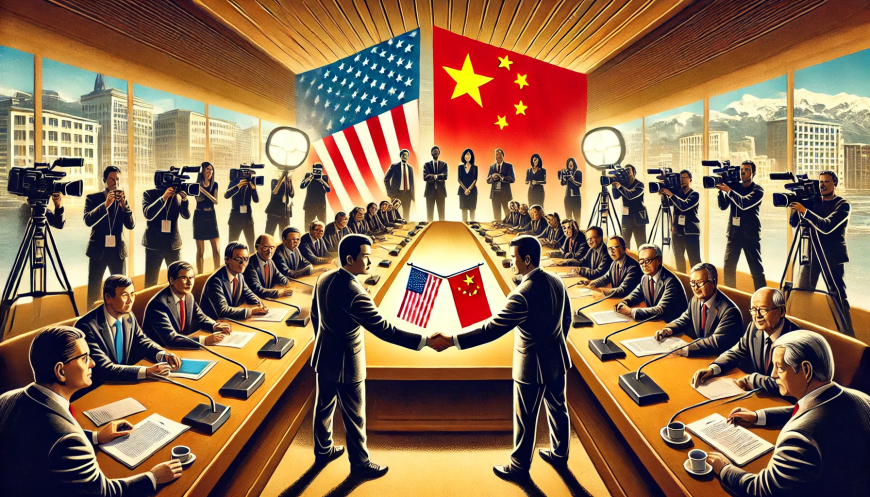Good News: Trump Secures Trade Deal with China Amid International Tensions
President Trump announces a historic trade agreement with China, easing tariffs and marking a turning point in U.S.-China relations amid global tensions.

A Historic Breakthrough After Intense Negotiations
Diplomacy and trade took center stage on the global agenda following an announcement from the Trump administration this weekend. The President of the United States confirmed that his team successfully reached a trade agreement with China — a move signaling an unexpected turn in a bilateral relationship marked by years of tariff wars, accusations of currency manipulation, and geopolitical disputes.
From Geneva, where negotiations were held, Treasury Secretary Scott Besson and U.S. Trade Representative Jameson Greer announced “substantial” progress in talks with their Chinese counterparts, outlining a framework for understanding to be detailed in the coming hours.
“The discussions were productive. I am confident the agreement will help address the national emergency declared by the President,” Besson told international media.
The Impact of Tariffs and Global Pressure
The deal arrives in a complex context. Since returning to the White House, President Trump imposed a series of aggressive tariffs — up to 145% — on Chinese goods including aluminum, steel, automobiles, and electronic components, in response to what he described as unfair trade practices by Beijing.
China responded with tariffs of up to 125% on American products, including agricultural goods, automobiles, and high-tech equipment. This standoff disrupted global supply chains, drove up prices, and roiled international markets.
The Trump administration argued these measures were necessary to balance a historically lopsided trade relationship and protect the interests of American workers and businesses.
A Deal Mirroring the U.K. Agreement
Though full details are expected Monday, diplomatic sources close to the process indicated the deal follows the model of the recently signed U.S.-U.K. trade agreement, which drastically reduced tariffs on steel, aluminum, and cars.
The U.S.-China deal aims to replicate this formula, easing tariffs for strategic sectors in both countries and establishing a framework for cooperation in areas such as intellectual property protection and market access.
“It’s an important first step, though much remains to be negotiated. The encouraging part is that there’s a framework on the table,” stated Republican Senator John Hoeven of North Dakota.
Trump Prepares for Middle East Tour
This diplomatic milestone is not isolated. The preliminary agreement coincides with President Trump’s preparations for his first international tour of his second term, starting Tuesday in Saudi Arabia, followed by visits to Qatar and the United Arab Emirates.
The President aims to reinforce strategic alliances in the region at a time when the U.S. is also engaged in nuclear negotiations with Iran. From Riyadh, correspondent Lucas Tomlinson reported that both sides praised progress in talks over Iran’s nuclear program, agreeing to reconvene in Oman.
China: A Key Player in the Middle East Equation
Beyond the trade agreement, China remains a pivotal player in the Middle East geopolitical landscape. As the primary buyer of Iranian oil and a military supplier in the region, Beijing holds sway over several of the world’s most delicate conflicts.
During a televised debate on Fox News, analysts David Webb and Lydia Hu emphasized how U.S.-China economic and strategic relations influence not only their respective economies but also the balance of power in regions like the Middle East and Central Asia.
“China is at the heart of all this. Its energy deals, indirect military presence, and global trade networks are crucial to any negotiation seeking to stabilize the region,” Webb noted.
Diplomacy, Conflict, and Economy: A Delicate Balance
Parallel to these agreements, the Trump administration is also managing other delicate diplomatic fronts. Among them is the expected release of the last American hostage held by Hamas in Gaza, 21-year-old Idon Alexander, scheduled for Tuesday to coincide with the President’s arrival in Saudi Arabia.
Additionally, Russian President Vladimir Putin proposed direct peace talks with Ukraine in Turkey in an effort to end over three years of conflict. Ukrainian President Volodymyr Zelensky accepted the meeting, conditional upon a ceasefire agreement.
This climate of simultaneous negotiations reveals an ambitious diplomatic strategy from the White House, seeking to secure successes in global trade, security, and geopolitics.
Market and Business Community Reaction
The announcement of the trade deal prompted immediate reactions in global stock markets, with notable gains in the Dow Jones and Nasdaq, fueled by hopes of easing trade tensions between the world’s two largest economies.
Major American corporations with stakes in China, such as Apple, General Motors, and Boeing, saw their shares rise in Monday’s pre-market trading. Should tariff reductions and new guarantees for intellectual property be confirmed, a gradual normalization of bilateral trade is expected.
What to Expect from the Official Announcement
According to official sources, the detailed announcement of the agreement will be made Monday from the White House. Expected points include:
- Progressive reduction of bilateral tariffs.
- Chinese commitments on intellectual property and cybersecurity.
- Expanded access for U.S. companies to the Chinese market.
- Review of China’s monetary practices.
- Establishment of a joint trade oversight committee.
U.S. Trade Representative Jameson Greer emphasized that while several details remain unresolved, this is a significant step that could stabilize economic relations and benefit global supply chains.
The announcement of the U.S.-China trade agreement under the Trump administration marks a turning point in a historically tense relationship. While challenges persist — including non-tariff barriers and intellectual property rights disputes — this progress offers a window of opportunity to ease tensions and strengthen economic ties.
In a world shaped by geopolitical uncertainties, from nuclear talks with Iran to war in Ukraine, these diplomatic steps provide a chance to steer major powers toward more stable and cooperative scenarios.
What's Your Reaction?
 Like
0
Like
0
 Dislike
0
Dislike
0
 Love
0
Love
0
 Funny
0
Funny
0
 Angry
0
Angry
0
 Sad
0
Sad
0
 Wow
0
Wow
0
































